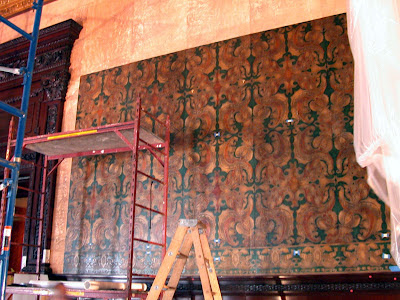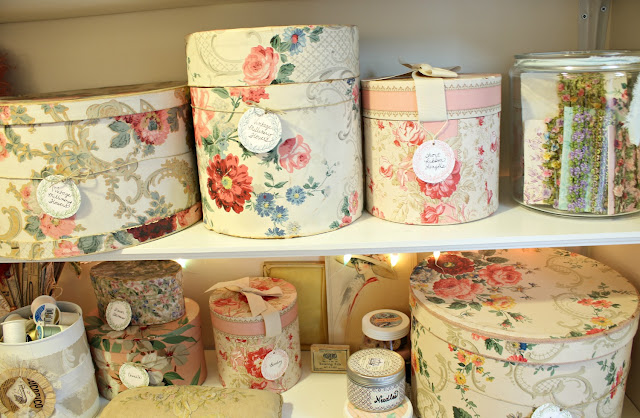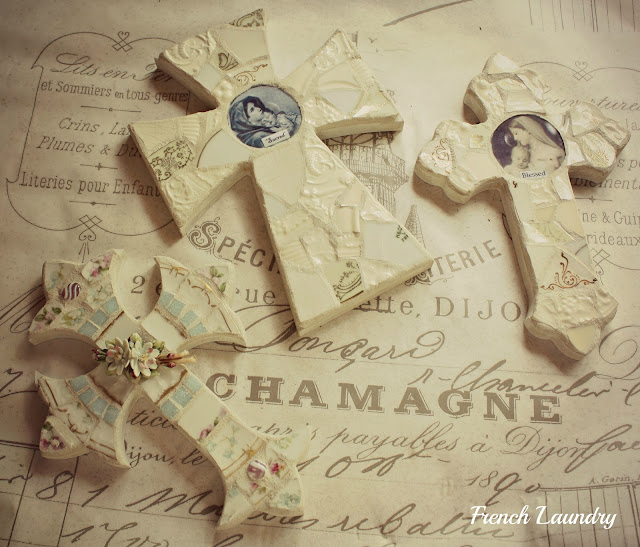Gilt Leather Installation: The Metlife Boardroom
Senin, 30 Juli 2012
0
komentar
1. “Dragon” pattern, contemporary gilded leather (Lutson Goudleder) |
A WALLPAPER (OK, LEATHER) CASE STUDY BY ROBERT M. KELLY
This post is about a leather installation for the Metlife Insurance Company which included the lamination, trimming and installation of over 400 panels of embossed, gilded and painted leather. But first, I want to mention the flurry of posts in the Wallpaper History Group on LinkedIn about leather, gilded and otherwise. Comparisons have been drawn in the discussion to paper, raised paper, Anaglypta, blown vinyl, and other materials.
The leather/paper connection is deep. During the first hundred years of wallpaper use (roughly 1650-1750) leather was a popular covering for walls among the upper classes, even if it was not often used floor-to-ceiling. Both materials were decorated, but paper could not be manhandled quite like leather, which was punched, prodded, pricked, and hammered to impress designs long before artisans embossed it from the other side to create a raised surface. Plate embossing began near Amsterdam around 1630. It’s not hard to appreciate the connection to flock wallpaper, which was being sold in quantity in London by 1700.
Leather and paper throughout this period were a sort of blank slate well-suited for carrying designs. Both were supple, porous, and reacted to moisture; joined together to form hangings; sometimes hung with a canvas underlayment; often nailed in place; and usually bordered. Even the size of the leather skins (20" x 27") was similar to the elephant size of paper. The repeating designs of early leather were circumscribed by the size of the skins. That was no handicap when they were hung on custom-built screens. When skins covered larger areas, the repeat patterns were often mirror-imaged. While effective, these rich designs had a curious inward-looking quality. It’s not surprising that many leather designs got larger and more graceful when they were transferred to wallpaper.
As the market for all types of "hangings" grew, some tradesmen and artisans exploited the opportunities. The exemplar of this tendency in the mid-18th century was Thomas Bromwich. Bromwich apprenticed to a leather worker and gained his freedom in 1737. He then became a linen draper, an upholder, a seller of screens and Chinese pictures, and wallpaper purveyor to the rich and famous. He was also Master of the Painter-Stainers’ Company in 1761. Yet, all this time he never quit the leather trade. He schooled twelve apprentices in leather craft.
There is much more about leather in Dr. Koldeweij's masterful article in the Furniture History journal: "Gilt Leather Hangings In Chinoiserie and Other Styles: An English Speciality." Furniture History 36 (2000): 61-101. I don't think this is online, though I would be glad to be wrong.
One of the interesting questions that came up on LinkedIn was this one: to what extent did late-19th century pattern designers for Anaglypta copy early leather patterns when creating new raised and gilt designs to decorate English and Scottish stately homes? While this connection has yet to be explored, it brings to mind that making an appealing wallpaper design is no easy thing. Patterns need to satisfy individual taste. At the same time, they need to be familiar, and this sense of decorum is especially important when furnishing traditional buildings. Some of this sense can be achieved by reaching back to late medieval and early modern design.
And on that note, here’s a link to an outstanding specimen of gilded leather, 1700 - 1730: prepare to be amazed, particularly with the close-up technology. Well-done, Rijksmuseum!
Rijksmuseum goudleer
It's wonderful that the close-ups show the stitching. This was necessary because of leather’s reaction to seasonal change. In the classic situation, a frame of wood was erected and a canvas underlayment stretched and tacked to insulate the work somewhat from the wall cavity. The leather was sewn together and tacked up on the frame, perhaps pulling a bit in a cross-like manner (I mean that the top center would probably have been tacked first, followed by bottom center, right center, left center, etc.) followed by finish tacking all the way round. Borders were applied to finish the installation, but now with gilt nails or other decorative fasteners for show. All of this was generally done in wet weather, so that the work would tighten up gradually as it dried. There are variations to the work (for example, we know that glue was sometimes used to adhere leather, especially when painting large areas was involved), but the method just outlined seems customary. The old techniques are hardly known here in the US outside of a museum context.
One interesting footnote is that around 1900 or so, these old techniques were revived in the US, by a Charles R. Yandell. It would be nice to know more about Mr. Yandell. I refer here to an article by Helen Henderson called “Wrought Leather,” found at this link:
"Wrought Leather", House and Garden, Vol. 4, pg. 227 (1903)
From Ms. Henderson’s article we learn that Yandell supplied leather for a house built by Charles Adams Platt for Francis T. Maxwell in Connecticut. I learned that Maxwell Court is still standing; it is now the home of the local Elk’s Club. The somewhat battered leather is still a point of pride.
What I found at the Elk’s Club was interesting. In the cleavages and missing spots we can still see the burlap stretched over an air space, the carpet tacks and gilt fasteners, the good-sized skins and narrower borders, too—and all of these things had been installed by Yandell in the old way, with needle, thread and hammer. The leather looked very old, but it was not possible to guess how the installation had been adapted. It seems likely that these sets of leather, like the better-known collections of Henry Marquand, had been imported from a gentleman’s club or smoking room in Europe. And before that, they probably came from a different country altogether, and who could guess their age? For all these reasons, they captured my attention.
But, I had a more practical reason to be attentive: business. Some time since I had worked with Frederic Poppe (Lutson Goudleder) on one of his jobs in the States, and Frederic’s company had been asked to replicate leather for an installation for the Metlife company in New York City. The Lutson company is based in southern France, though Poppe and his wife, Lut, are from Belgium. At the time I visited Maxwell Court, I was gathering information for an alternate proposal to hang the new leather which had just been ordered from the Lutson workshops.
The project was gigantic. It consisted of dismantling the executive boardroom at One Madison Avenue, and re-establishing it in mid-town (this was actually the second removal of the boardroom, but more about that in a minute). The boardroom consisted largely of French-polished mahogany woodwork bristling with detail and an equally elaborate gilded ceiling divided into perhaps a dozen deep coffers. All of this fine material was disassembled and transported to the penthouse floor of the former Pan Am building which sits atop Grand Central Station.
 |
| 2. removing ceiling, 2004 |
Now, about that first removal......
The headquarters of the Metropolitan Life Insurance Company was built in 1893. In 1909 the Tower was added; it’s now known as the Metlife Tower. We know from a 1914 company history (link below) that the boardroom was on the second floor of the home office adjacent to the new tower. In all probability that was its original location. The Metlife Company seems always to have put some effort into their building programs. The Metlife Tower (constructed in 1909) is 700 feet tall and modeled after the campanile at St. Mark’s Square in Venice. The Tower was the tallest building in the world, but only for a few years. The north building at One Madison, across the park, was supposed to be 100 stories tall, and thus would have easily recaptured the title, but construction ceased at the 29th floor during the Depression.
On pp. 79 and 81 of the company history are photos of the boardroom, showing leather, gilt ceiling and carved woodwork. The writers carefully point out that the furnishings are magnificent and yet surprisingly cost-effective: “It is a splendid room, 26 x 36, trimmed in richly carved Santo Domingo mahogany, with a monumental mantel designed after one in the Chateau de Villeroy. Its walls are covered with leather, and the ceiling, which is of ornamental plaster, is faced with gold-leaf—in the end most economical in cost, for age improves it and it will never need any attention or repair.”
The Metropolitan Life Insurance Company (booklet, 1914)
This statement proved not entirely true because when the original Home office was demolished, around 1960, the boardroom ceiling, fireplace, and woodwork was disassembled, carted across a Madison Square Park, and reassembled on the eleventh floor of the north building at One Madison Avenue. And there it stayed until the second removal in 2004. I visited One Madison just before the second removal. The room was buzzing with workers taking photos and scaled shop drawings in anticipation of putting it all back together.
Part of the contract involved stripping the existing leather. The leather that was installed directly to the walls during the 60’s was a reproduction and replaced the original set of leather visible in the photos from 1914.
In an odd coincidence, another executive room decorated in leather, also that of a major insurance company, also in New York, but belonging to the president of the New York Life Insurance Company, appears in Helen Henderson’s 1903 article (referred to above) on page 233. There it's stated that Charles Yandell created the leather on the walls. The photo is so poor and the historic record so vague that it’s not possible to know if this rendition was sewn or put directly to the wall. Around this time there were several successful New York insurance companies known as the Big Three (Metropolitan was the Fourth). They had much in common: opulent headquarters, leather-clad boardrooms, and financial scandals—a byway we will not pursue here.
Now, let’s get back to the Metropolitan Life Insurance Company boardroom, which, as you remember, started life in 1893 or so, was removed to the upper stories of the north building (One Madison) around 1960, and was moved again in 2004-05 to Grand Central. During the visits it was interesting to see that the 60s installation had been centered on each good-sized wall space, so that mismatches appeared almost exclusively in corners. No doubt this was done to respect the grand nature of the woodwork, fireplace and door designs. For the replication, as in the 60s installation, it was planned to use mirror-images and double-cuts to bring the panels together. The “kill points” (mismatches) were reserved for corners, for the most part.
 |
| 3. bay area, 60s installation |
One of the persistent criticisms of wallpaper is that it erases architectural lines within the room, substituting a “flood of ornament” for a proper attention to boundaries. That seems a little unfair. Sometimes a flood of ornament is just what the lines of the room call for. But here, the leather pattern needed to be centered within prominent spaces, not so much because it was leather, but because of its symmetrical design. This quote is drawn from the alternate proposal:
“The previous installers used the center point of every significant horizontal space as a central axis. They followed this axis up and continued the match, working toward the center of the door and window headers. At the center point of the doors and windows they brought the patterns together. In almost every instance this resulted in a unique but symmetrical shape in the center of the architectural element. Because the pattern lends itself to such creative shaping, there is no jarring mismatch in the existing patterns on the wall. Nor is there a likelihood of noticeable mismatches in the new installation for the same reason. Shop drawings using acetates and pencil sketches are supplied with this bid which show the proposed location and numbers of panels.”
Site visits to One Madison confirmed that the leather installed in the 60s had sustained such damage that removal and reinstallation were not feasible. The 60s leather had been put directly to the wall with clay-based adhesives, which at that time were becoming the standard for oilcloth and a fresh new product—solid vinyl wallcoverings. The plywood under the leather had shifted often, producing stress cracks and voids; surface damage from UV, cleaning agents, oxidation and the like had taken a toll. This explains why a reproduction had been commissioned from Lutson, who would use traditional embossing, gilding and coloring techniques to create the new leather.
 |
| 4. stripping: two full panel heights over lower border |
 |
| 5. full panel, 60s installation |
Potential movement of the substrate was addressed by specifying marine birch plywood fastened into concrete with plenty of metal countersinking under a wooden block support system. The channels between wood panels would be finished with plywood splines glued in and sanded smooth, and patched and sanded to form a continuous surface.
The specifications for the leather installation took many hours of testing. A low-moisture system was settled on. The birch would be primed with two coats of an acrylic urethane. This would be followed by rigorous sanding with 80 grit and vacuuming. The surface would be topcoated with an acrylic wallcovering primer. A polymuslin (synthetic close-knit lightweight cloth) would be adhered to the wall in large widths. The adhesive would be a strippable machine clay. The polymuslin would then be topcoated with more acrylic wallcovering primer.
Testing showed that a clay and polymuslin lamination system worked well for stabilizing the leather panels. In other words, each embossed, gilded and painted panel was laminated in the US with a slightly larger piece of polymuslin using minimal amounts of starch/polymer adhesive. The panels were allowed to dry thoroughly. Blotters were interleaved for additional reduction of moisture. Trimming followed.
We found that trimming the leather on large sheets of plate glass with brassbound straightedges, framer’s squares and heavy-duty Olfa knives gave the best results. During testing the expansion and contraction of the leather became a matter of some study. The panels waxed and waned for many reasons: because they were freshly fabricated and painted; because of the lamination (which introduced moisture); and because of the change in climate from France to Boston to New York. As a control test batches were measured down to the 16th and even to the 32nd of an inch. The changes were written down and tabulated.
 |
| 6. installation at One Madison, 2004 |
For the installation, lasers on various levels of the scaffold were set up; these projected a cross-haired full-wall grid. The quarter and half-panel trim sizes were adjusted as the full panels were completed on the wall. In this way the design was controlled as it moved up and down the wall. There was no tolerance, but there was an escape route. If need be, a panel could be shaved a bit on the wall. This option came in handy.
I should not close without saluting the members of the installation team who helped me carry out this interesting and challenging assignment, all of whom are skilled professional paperhangers: Barry Blanchard, Jim Yates, Eileen Carroll, Lynne Parker, and Anthony Russo. Another essential part of the team, especially in the testing phases, was the leather conservator, Alexandra Allardt.
 |
| 7. installation at Grand Central, 2005 |
_____
Alexandra Allardt has a conservation practice in Newport, Rhode Island, Artcare Resources:
http://www.artcareresources.com/
Lutson Goudleder: www.lutson.com
Rijks Museum
“Wrought Leather” by Helen Henderson (House and Garden), 1903.
“The Metropolitan Life Insurance Company”, booklet, 1914:
Photo Credits: 1. “Dragon” pattern, contemporary gilded leather (Lutson Goudleder): courtesy Frederic Poppe; 2. removing ceiling, 2004: courtesy of www.artcareresources.com; 3. centered pattern, 60’s installation: courtesy of WallpaperScholar.Com; 4. stripping: two full panel heights over lower border: courtesy of www.artcareresources.com 5. full panel, 60’s material: courtesy of WallpaperScholar.Com; quarter-panel design, cropped from 60’s material: courtesy of WallpaperScholar.Com; 6. installation at One Madison, 2004: courtesy of WallpaperScholar.Com; 7. installation at Grand Central, 2005: courtesy of WallpaperScholar.Com.
Baca Selengkapnya ....
























































